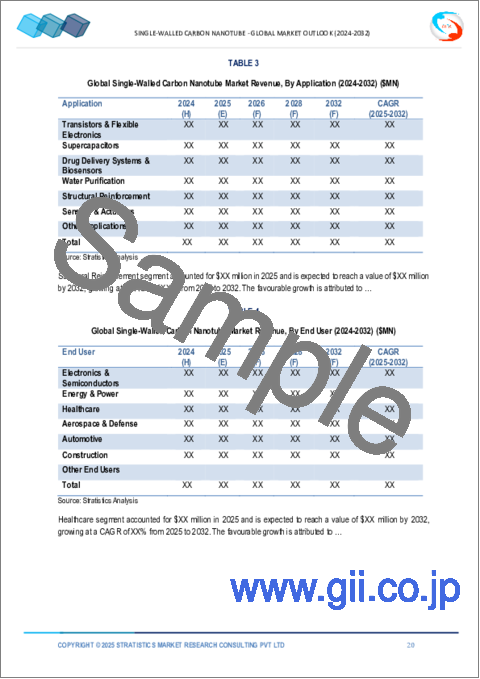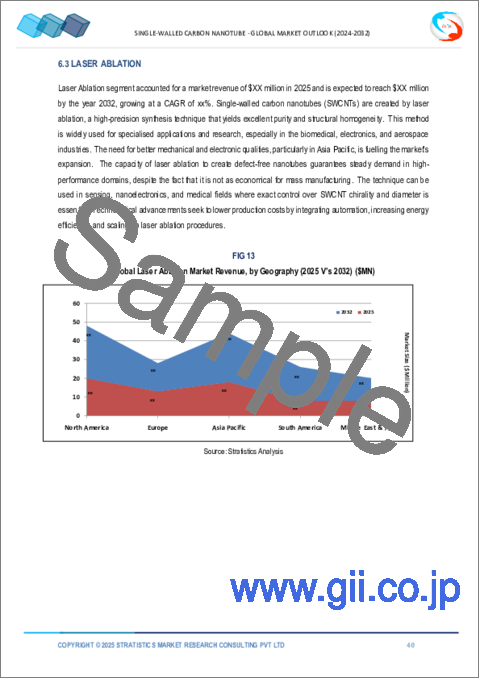|
|
市場調査レポート
商品コード
1662669
単層カーボンナノチューブの2030年までの市場予測: 製品タイプ、合成方法、用途、エンドユーザー、地域別の世界分析Single-Walled Carbon Nanotube Market Forecasts to 2030 - Global Analysis By Product Type (Closed Armchair, Zigzag, Chiral and Other Product Types), Synthesis Method, Application, End User and By Geography |
||||||
カスタマイズ可能
|
|||||||
| 単層カーボンナノチューブの2030年までの市場予測: 製品タイプ、合成方法、用途、エンドユーザー、地域別の世界分析 |
|
出版日: 2025年02月02日
発行: Stratistics Market Research Consulting
ページ情報: 英文 200+ Pages
納期: 2~3営業日
|
- 全表示
- 概要
- 図表
- 目次
Stratistics MRCによると、世界の単層カーボンナノチューブ市場は2024年に11億7,000万米ドルを占め、予測期間中のCAGRは52.0%で成長し、2030年には144億米ドルに達する見込みです。
単層カーボンナノチューブ(SWCNT)は、六角形格子に配置された炭素原子の単層からなる円筒構造です。グラフェンシートをシームレスな円筒状に巻くことで形成されます。SWCNTは、引張強度、電気伝導性、熱安定性などの優れた物理的特性を持っています。その電気的特性は、炭素原子の"キラリティ "によって金属性にも半導体性にもなります。SWCNTは、電気を効率よく伝導するため、エレクトロニクス、ナノ技術、エネルギー貯蔵などの用途に理想的です。その可能性から、合成、機能化、実用技術への統合に関する研究が盛んに行われています。
卓越した材料特性
卓越した材料特性には、並外れた引張強度、電気伝導性、熱安定性などがあります。これらの特性により、SWCNTは、エレクトロニクスからエネルギー貯蔵に至るまで、幅広い産業で高い価値を発揮しています。SWCNTは、その長さ方向に電気を伝導するユニークな能力を持ち、軽量で高強度であるため、アプリケーションに最適です。航空宇宙、自動車、建築セグメントでの軽量・高強度材料への需要の高まりが、単層カーボンナノチューブ市場をさらに牽引しています。
複雑な製造プロセスと特殊設備
高品質の単層カーボンナノチューブを製造するには、化学気相成長法(CVD)やアーク放電法などの特殊な装置や技術が必要であり、これらは高価で規模を拡大するのが難しいです。さらに、製造中にカイラリティを制御することは複雑な作業であり、わずかな構造の変化でも特性や性能に劇的な影響を与える可能性があります。これらの要因により、単層カーボンナノチューブの入手が制限され、製造コストが上昇するため、市場の成長が制限されます。
軽量・高強度材料への需要の高まり
自動車、航空宇宙、エレクトロニクスなどの産業では、強度を犠牲にすることなく性能を向上させ軽量化するために、ナノチューブのような先進ナノ材料への注目が高まっています。特に、ポリマー、セラミック、金属の機械的特性を向上させるSWCNTは、構造部品の複合材料に利用されつつあります。電気自動車(EV)やその他の高性能アプリケーションの台頭により、効率向上のために軽量かつ高強度な材料が必要とされるため、単層カーボンナノチューブベースの材料に対する需要が高まることが予想されます。
潜在的な健康・環境リスク
カーボンナノチューブの吸入は呼吸器系の問題につながる可能性があり、また、サイズが小さいため生体膜を透過する可能性があることが研究で示されています。さらに、単層カーボン・ナノチューブの廃棄と環境における潜在的な毒性は、長期的な生態系への影響を懸念させています。単層カーボンナノチューブの市場が拡大するにつれ、安全な使用を確保し、市場成長の妨げとなる規制上の制限を防ぐためには、こうした健康リスクや環境リスクへの対処が極めて重要になります。
COVID-19の影響
製造の遅れや研究活動の減少は、新たな用途やイノベーションの開発速度に影響を与えました。一方、パンデミックは、医療機器、個人用保護具(PPE)、エネルギー貯蔵ソリューションなどのセグメントにおけるSWCNTを含む先端材料の重要性を浮き彫りにしました。産業がパンデミック後の現実に適応するにつれ、ナノ技術や先端材料への関心が再び高まっています。医療、エネルギー、エレクトロニクスにおける革新的ソリューションへのニーズの高まりは、単層カーボンナノチューブ市場の回復と拡大を加速させると予想されます。
予測期間中、アームチェアセグメントが最大になる見込み
アームチェアセグメントは、その金属的性質により、従来の材料と比較して高い通電容量と低い抵抗損失を提供するため、予測期間中に最大の市場シェアを占めると予想されます。これは、民生用電子機器や半導体産業における性能向上につながります。また、導電率が高く表面積が大きいため、スーパーキャパシタやバッテリーのエネルギー貯蔵・生成用としても検討されており、電気自動車や再生可能エネルギー発電システムのようなエネルギー効率の高い技術に最適です。
予測期間中、レーザーアブレーションセグメントのCAGRが最も高くなる見込み
予測期間中、量子コンピューティング、ナノセンサ、高強度複合材料などの最先端技術により、レーザーアブレーションセグメントの成長率が最も高くなると予測されています。これらの用途では、不純物が少なく均一性の高い材料が必要とされるが、レーザーアブレーションではこれを実現できます。航空宇宙、自動車、エレクトロニクスなどの産業では、このような先端材料への需要が高まっており、レーザーアブレーション技術の採用が市場成長を後押ししています。
最大シェアの地域
予測期間中、北米地域は、改善されたキラリティ制御、構造均一性、スケーラビリティを持つ超伝導ウェッジナノチューブ(SWCNT)を合成するための先進的手法により、最大の市場シェアを占めると予想されます。化学気相成長法、レーザーアブレーション法、プラズマエンハンスト成長法などです。また、大学や企業のラボでは、単層カーボンナノチューブをエネルギー貯蔵、フレキシブルエレクトロニクス、先進センサなどの特定の使用事例向けにカスタマイズし、既存技術へのシームレスな統合を実現しています。
CAGRが最も高い地域
予測期間中、アジア太平洋は、電気自動車(EV)の車両効率と航続距離を改善するためのシャーシ、ボディパネル、フレームなどの軽量構造部品により、最も高いCAGRを示すと予測されます。SWCNTは、排ガス規制を満たし、高性能車や高級車の性能を向上させます。SWCNTはまた、自律走行、接続性、安全機能のための先進的なセンサやエレクトロニクスにも使用されており、スマートカーや自律走行車の開発をサポートし、アジア太平洋自動車セクターの需要を牽引しています。
無料カスタマイズサービス
本レポートをご購読の顧客には、以下の無料カスタマイズオプションのいずれかをご利用いただけます。
- 企業プロファイル
- 追加市場参入企業の包括的プロファイリング(3社まで)
- 主要企業のSWOT分析(3社まで)
- 地域セグメンテーション
- 顧客の関心に応じた主要国の市場推定・予測・CAGR(注:フィージビリティチェックによる)
- 競合ベンチマーキング
- 製品ポートフォリオ、地理的プレゼンス、戦略的提携による主要企業のベンチマーキング
目次
第1章 エグゼクティブサマリー
第2章 序文
- 概要
- ステークホルダー
- 調査範囲
- 調査手法
- データマイニング
- データ分析
- データ検証
- 調査アプローチ
- 調査情報源
- 1次調査情報源
- 2次調査情報源
- 前提条件
第3章 市場動向分析
- イントロダクション
- 促進要因
- 抑制要因
- 機会
- 脅威
- 製品分析
- 用途分析
- エンドユーザー分析
- 新興市場
- COVID-19の影響
第4章 ポーターのファイブフォース分析
- 供給企業の交渉力
- 買い手の交渉力
- 代替品の脅威
- 新規参入業者の脅威
- 競争企業間の敵対関係
第5章 世界の単層カーボンナノチューブ市場:製品タイプ別
- イントロダクション
- アームチェア
- ジグザグ
- キラル
- その他
第6章 世界の単層カーボンナノチューブ市場:合成方法別
- イントロダクション
- アーク放電
- レーザーアブレーション
- 化学蒸着法(CVD)
- その他の合成方法
第7章 世界の単層カーボンナノチューブ市場:用途別
- イントロダクション
- トランジスタとフレキシブルエレクトロニクス
- スーパーキャパシタ
- ドラッグデリバリーシステムとバイオセンサ
- 水の浄化
- 構造補強
- センサとアクチュエータ
- その他
第8章 世界の単層カーボンナノチューブ市場:エンドユーザー別
- イントロダクション
- エレクトロニクスと半導体
- エネルギーと電力
- 医療
- 航空宇宙と防衛
- 自動車
- 建設
- その他
第9章 世界の単層カーボンナノチューブ市場:地域別
- イントロダクション
- 北米
- 米国
- カナダ
- メキシコ
- 欧州
- ドイツ
- 英国
- イタリア
- フランス
- スペイン
- その他の欧州
- アジア太平洋
- 日本
- 中国
- インド
- オーストラリア
- ニュージーランド
- 韓国
- その他のアジア太平洋
- 南米
- アルゼンチン
- ブラジル
- チリ
- その他の南米
- 中東・アフリカ
- サウジアラビア
- アラブ首長国連邦
- カタール
- 南アフリカ
- その他の中東・アフリカ
第10章 主要開発
- 契約、パートナーシップ、コラボレーション、合弁事業
- 買収と合併
- 新製品発売
- 事業拡大
- その他の主要戦略
第11章 企業プロファイリング
- Arkema SA
- Arry International Group Limited
- Cabot Corporation
- Carbon Solutions, Inc.
- Hanwha Chemical Corporation
- Hyperion Catalysis International
- Jiangsu Cnano Technology Co., Ltd.
- Klean Commodities
- Nanocyl SA
- NanoLab
- Nanoshell LLC
- NoPo Nanotechnologies
- OCSiAl
- Showa Denko K.K.
- Thomas Swan & Co. Ltd.
List of Tables
- Table 1 Global Single-Walled Carbon Nanotube Market Outlook, By Region (2022-2030) ($MN)
- Table 2 Global Single-Walled Carbon Nanotube Market Outlook, By Product Type (2022-2030) ($MN)
- Table 3 Global Single-Walled Carbon Nanotube Market Outlook, By Armchair (2022-2030) ($MN)
- Table 4 Global Single-Walled Carbon Nanotube Market Outlook, By Zigzag (2022-2030) ($MN)
- Table 5 Global Single-Walled Carbon Nanotube Market Outlook, By Chiral (2022-2030) ($MN)
- Table 6 Global Single-Walled Carbon Nanotube Market Outlook, By Other Product Types (2022-2030) ($MN)
- Table 7 Global Single-Walled Carbon Nanotube Market Outlook, By Synthesis Method (2022-2030) ($MN)
- Table 8 Global Single-Walled Carbon Nanotube Market Outlook, By Arc Discharge (2022-2030) ($MN)
- Table 9 Global Single-Walled Carbon Nanotube Market Outlook, By Laser Ablation (2022-2030) ($MN)
- Table 10 Global Single-Walled Carbon Nanotube Market Outlook, By Chemical Vapor Deposition (CVD) (2022-2030) ($MN)
- Table 11 Global Single-Walled Carbon Nanotube Market Outlook, By Other Synthesis Methods (2022-2030) ($MN)
- Table 12 Global Single-Walled Carbon Nanotube Market Outlook, By Application (2022-2030) ($MN)
- Table 13 Global Single-Walled Carbon Nanotube Market Outlook, By Transistors & Flexible Electronics (2022-2030) ($MN)
- Table 14 Global Single-Walled Carbon Nanotube Market Outlook, By Supercapacitors (2022-2030) ($MN)
- Table 15 Global Single-Walled Carbon Nanotube Market Outlook, By Drug Delivery Systems & Biosensors (2022-2030) ($MN)
- Table 16 Global Single-Walled Carbon Nanotube Market Outlook, By Water Purification (2022-2030) ($MN)
- Table 17 Global Single-Walled Carbon Nanotube Market Outlook, By Structural Reinforcement (2022-2030) ($MN)
- Table 18 Global Single-Walled Carbon Nanotube Market Outlook, By Sensors & Actuators (2022-2030) ($MN)
- Table 19 Global Single-Walled Carbon Nanotube Market Outlook, By Other Applications (2022-2030) ($MN)
- Table 20 Global Single-Walled Carbon Nanotube Market Outlook, By End User (2022-2030) ($MN)
- Table 21 Global Single-Walled Carbon Nanotube Market Outlook, By Electronics & Semiconductors (2022-2030) ($MN)
- Table 22 Global Single-Walled Carbon Nanotube Market Outlook, By Energy & Power (2022-2030) ($MN)
- Table 23 Global Single-Walled Carbon Nanotube Market Outlook, By Healthcare (2022-2030) ($MN)
- Table 24 Global Single-Walled Carbon Nanotube Market Outlook, By Aerospace & Defense (2022-2030) ($MN)
- Table 25 Global Single-Walled Carbon Nanotube Market Outlook, By Automotive (2022-2030) ($MN)
- Table 26 Global Single-Walled Carbon Nanotube Market Outlook, By Construction (2022-2030) ($MN)
- Table 27 Global Single-Walled Carbon Nanotube Market Outlook, By Other End Users (2022-2030) ($MN)
Note: Tables for North America, Europe, APAC, South America, and Middle East & Africa Regions are also represented in the same manner as above.
According to Stratistics MRC, the Global Single-Walled Carbon Nanotube Market is accounted for $1.17 billion in 2024 and is expected to reach $14.4 billion by 2030 growing at a CAGR of 52.0% during the forecast period. Single-Walled Carbon Nanotubes (SWCNTs) are cylindrical structures made of a single layer of carbon atoms arranged in a hexagonal lattice. They are formed by rolling a graphene sheet into a seamless cylinder. SWCNTs have remarkable physical properties, including tensile strength, electrical conductivity, and thermal stability. Their electrical characteristics can be metallic or semiconducting, depending on the carbon atom's "chirality." SWCNTs are highly efficient in conducting electricity, making them ideal for applications in electronics, nanotechnology, and energy storage. Their potential has led to significant research into their synthesis, functionalization, and integration into practical technologies.
Market Dynamics:
Driver:
Exceptional material properties
Exceptional material properties include extraordinary tensile strength, electrical conductivity and thermal stability. These properties make SWCNTs highly valuable in a wide range of industries, from electronics to energy storage. Their unique ability to conduct electricity along their length, combined with their lightweight and high-strength characteristics, makes them ideal for applications. The growing demand for lightweight and high-strength materials in aerospace, automotive, and construction sectors further drives the single-walled carbon nanotube market.
Restraint:
Complex manufacturing processes and specialized equipment
Producing high-quality single-walled carbon nanotube requires specialized equipment and techniques, such as chemical vapor deposition (CVD) or arc discharge, which can be expensive and difficult to scale. Additionally, controlling the chirality during production is a complex task, as even slight variations in their structure can dramatically affect their properties and performance. These factors limit the availability of single-walled carbon nanotube and increase production costs, restricting market growth.
Opportunity:
Increasing demand for lightweight and high-strength materials
Industries such as automotive, aerospace and electronics are increasingly turning to advanced nanomaterials like nanotubes to improve performance and reduce weight without sacrificing strength. In particular, the use of SWCNTs in composite materials for structural components is gaining traction due to their ability to improve the mechanical properties of polymers, ceramics, and metals. The rise of electric vehicles (EVs) and other high-performance applications, which require lighter and stronger materials for improved efficiency, is expected to drive demand for single-walled carbon nanotube -based materials.
Threat:
Potential health and environmental risks
Studies have shown that inhalation of carbon nanotubes can lead to respiratory issues, and their small size allows them to potentially penetrate biological membranes. Moreover, the disposal of single-walled carbon nanotube and their potential toxicity in the environment raise concerns about long-term ecological effects. As the market for single-walled carbon nanotube expands, addressing these health and environmental risks will become crucial to ensuring safe use and preventing regulatory restrictions that could hinder market growth.
Covid-19 Impact
Manufacturing delays and reduced research activities affected the rate at which new applications and innovations were developed. On the other hand, the pandemic highlighted the importance of advanced materials, including SWCNTs, in areas such as medical devices, personal protective equipment (PPE), and energy storage solutions. As industries adapt to post-pandemic realities, there is renewed interest in nanotechnology and advanced materials. The growing need for innovative solutions in healthcare, energy, and electronics is expected to accelerate the recovery and expansion of the single-walled carbon nanotube market.
The armchair segment is expected to be the largest during the forecast period
The armchair segment is expected to account for the largest market share during the forecast period due to their metallic nature, offering higher current-carrying capacity and lower resistive losses compared to traditional materials. This leads to improved performance in consumer electronics and semiconductor industries. They are also being explored for energy storage and generation in supercapacitors and batteries due to their high electrical conductivity and larger surface area, making them ideal for energy-efficient technologies like electric vehicles and renewable energy systems.
The laser ablation segment is expected to have the highest CAGR during the forecast period
Over the forecast period, the laser ablation segment is predicted to witness the highest growth rate due to cutting-edge technologies, such as quantum computing, nanosensors, and high-strength composites. These applications require materials with minimal impurities and high uniformity, which laser ablation, can deliver. The growing demand for such advanced materials in industries like aerospace, automotive, and electronics supports the adoption of laser ablation techniques driving the market growth.
Region with largest share:
During the forecast period, the North America region is expected to hold the largest market share due to advanced methods for synthesizing superconducting wedge nanotubes (SWCNTs) with improved chirality control, structural uniformity, and scalability. Techniques like chemical vapor deposition, laser ablation, and plasma-enhanced growth. Universities and corporate research labs are also tailoring single-walled carbon nanotube for specific use cases like energy storage, flexible electronics, and advanced sensors, ensuring seamless integration into existing technologies.
Region with highest CAGR:
Over the forecast period, the Asia Pacific region is anticipated to exhibit the highest CAGR owing to lightweight structural components like chassis, body panels, and frames to improve vehicle efficiency and range in electric vehicles (EVs). They meet emission standards and enhance performance in high-performance and luxury vehicles. SWCNTs are also being used in advanced sensors and electronics for autonomous driving, connectivity, and safety features, supporting the development of smart and autonomous vehicles, driving demand in the APAC automotive sector.
Key players in the market
Some of the key players in Single-Walled Carbon Nanotube market include Arkema SA , Arry International Group Limited , Cabot Corporation, Carbon Solutions, Inc., Hanwha Chemical Corporation, Hyperion Catalysis International, Jiangsu Cnano Technology Co., Ltd., Klean Commodities, Nanocyl SA, NanoLab , Nanoshell LLC, NoPo Nanotechnologies, OCSiAl, Showa Denko K.K. and Thomas Swan & Co. Ltd.
Key Developments:
In January 2025, Arkema and ALBIS partner in the distribution of high-performance medical-grade polymers for the healthcare market. These polymers are known for their chemical resistance, flexibility and compliance with industry standards, supporting the strict requirements of manufacturers in the healthcare field.
In December 2024, Arkema finalized he acquisition of Dow's flexible packaging laminating adhesives business, one of the leading global producers of adhesives for the flexible packaging market.
In August 2024, Array unveiled SkyLink tracker system to maximize solar efficiency in extreme weather & reduce costs, a revolutionary PV-powered wireless tracker system that builds on the capabilities of DuraTrack(R) and OmniTrack(TM) offerings.
Product Types Covered:
- Armchair
- Zigzag
- Chiral
- Other Product Types
Synthesis Methods Covered:
- Arc Discharge
- Laser Ablation
- Chemical Vapor Deposition (CVD)
- Other Synthesis Methods
Applications Covered:
- Transistors & Flexible Electronics
- Supercapacitors
- Drug Delivery Systems & Biosensors
- Water Purification
- Structural Reinforcement
- Sensors & Actuators
- Other Applications
End Users Covered:
- Electronics & Semiconductors
- Energy & Power
- Healthcare
- Aerospace & Defense
- Automotive
- Construction
- Other End Users
Regions Covered:
- North America
- US
- Canada
- Mexico
- Europe
- Germany
- UK
- Italy
- France
- Spain
- Rest of Europe
- Asia Pacific
- Japan
- China
- India
- Australia
- New Zealand
- South Korea
- Rest of Asia Pacific
- South America
- Argentina
- Brazil
- Chile
- Rest of South America
- Middle East & Africa
- Saudi Arabia
- UAE
- Qatar
- South Africa
- Rest of Middle East & Africa
What our report offers:
- Market share assessments for the regional and country-level segments
- Strategic recommendations for the new entrants
- Covers Market data for the years 2022, 2023, 2024, 2026, and 2030
- Market Trends (Drivers, Constraints, Opportunities, Threats, Challenges, Investment Opportunities, and recommendations)
- Strategic recommendations in key business segments based on the market estimations
- Competitive landscaping mapping the key common trends
- Company profiling with detailed strategies, financials, and recent developments
- Supply chain trends mapping the latest technological advancements
Free Customization Offerings:
All the customers of this report will be entitled to receive one of the following free customization options:
- Company Profiling
- Comprehensive profiling of additional market players (up to 3)
- SWOT Analysis of key players (up to 3)
- Regional Segmentation
- Market estimations, Forecasts and CAGR of any prominent country as per the client's interest (Note: Depends on feasibility check)
- Competitive Benchmarking
- Benchmarking of key players based on product portfolio, geographical presence, and strategic alliances
Table of Contents
1 Executive Summary
2 Preface
- 2.1 Abstract
- 2.2 Stake Holders
- 2.3 Research Scope
- 2.4 Research Methodology
- 2.4.1 Data Mining
- 2.4.2 Data Analysis
- 2.4.3 Data Validation
- 2.4.4 Research Approach
- 2.5 Research Sources
- 2.5.1 Primary Research Sources
- 2.5.2 Secondary Research Sources
- 2.5.3 Assumptions
3 Market Trend Analysis
- 3.1 Introduction
- 3.2 Drivers
- 3.3 Restraints
- 3.4 Opportunities
- 3.5 Threats
- 3.6 Product Analysis
- 3.7 Application Analysis
- 3.8 End User Analysis
- 3.9 Emerging Markets
- 3.10 Impact of Covid-19
4 Porters Five Force Analysis
- 4.1 Bargaining power of suppliers
- 4.2 Bargaining power of buyers
- 4.3 Threat of substitutes
- 4.4 Threat of new entrants
- 4.5 Competitive rivalry
5 Global Single-Walled Carbon Nanotube Market, By Product Type
- 5.1 Introduction
- 5.2 Armchair
- 5.3 Zigzag
- 5.4 Chiral
- 5.5 Other Product Types
6 Global Single-Walled Carbon Nanotube Market, By Synthesis Method
- 6.1 Introduction
- 6.2 Arc Discharge
- 6.3 Laser Ablation
- 6.4 Chemical Vapor Deposition (CVD)
- 6.5 Other Synthesis Methods
7 Global Single-Walled Carbon Nanotube Market, By Application
- 7.1 Introduction
- 7.2 Transistors & Flexible Electronics
- 7.3 Supercapacitors
- 7.4 Drug Delivery Systems & Biosensors
- 7.5 Water Purification
- 7.6 Structural Reinforcement
- 7.7 Sensors & Actuators
- 7.8 Other Applications
8 Global Single-Walled Carbon Nanotube Market, By End User
- 8.1 Introduction
- 8.2 Electronics & Semiconductors
- 8.3 Energy & Power
- 8.4 Healthcare
- 8.5 Aerospace & Defense
- 8.6 Automotive
- 8.7 Construction
- 8.8 Other End Users
9 Global Single-Walled Carbon Nanotube Market, By Geography
- 9.1 Introduction
- 9.2 North America
- 9.2.1 US
- 9.2.2 Canada
- 9.2.3 Mexico
- 9.3 Europe
- 9.3.1 Germany
- 9.3.2 UK
- 9.3.3 Italy
- 9.3.4 France
- 9.3.5 Spain
- 9.3.6 Rest of Europe
- 9.4 Asia Pacific
- 9.4.1 Japan
- 9.4.2 China
- 9.4.3 India
- 9.4.4 Australia
- 9.4.5 New Zealand
- 9.4.6 South Korea
- 9.4.7 Rest of Asia Pacific
- 9.5 South America
- 9.5.1 Argentina
- 9.5.2 Brazil
- 9.5.3 Chile
- 9.5.4 Rest of South America
- 9.6 Middle East & Africa
- 9.6.1 Saudi Arabia
- 9.6.2 UAE
- 9.6.3 Qatar
- 9.6.4 South Africa
- 9.6.5 Rest of Middle East & Africa
10 Key Developments
- 10.1 Agreements, Partnerships, Collaborations and Joint Ventures
- 10.2 Acquisitions & Mergers
- 10.3 New Product Launch
- 10.4 Expansions
- 10.5 Other Key Strategies
11 Company Profiling
- 11.1 Arkema SA
- 11.2 Arry International Group Limited
- 11.3 Cabot Corporation
- 11.4 Carbon Solutions, Inc.
- 11.5 Hanwha Chemical Corporation
- 11.6 Hyperion Catalysis International
- 11.7 Jiangsu Cnano Technology Co., Ltd.
- 11.8 Klean Commodities
- 11.9 Nanocyl SA
- 11.10 NanoLab
- 11.11 Nanoshell LLC
- 11.12 NoPo Nanotechnologies
- 11.13 OCSiAl
- 11.14 Showa Denko K.K.
- 11.15 Thomas Swan & Co. Ltd.






